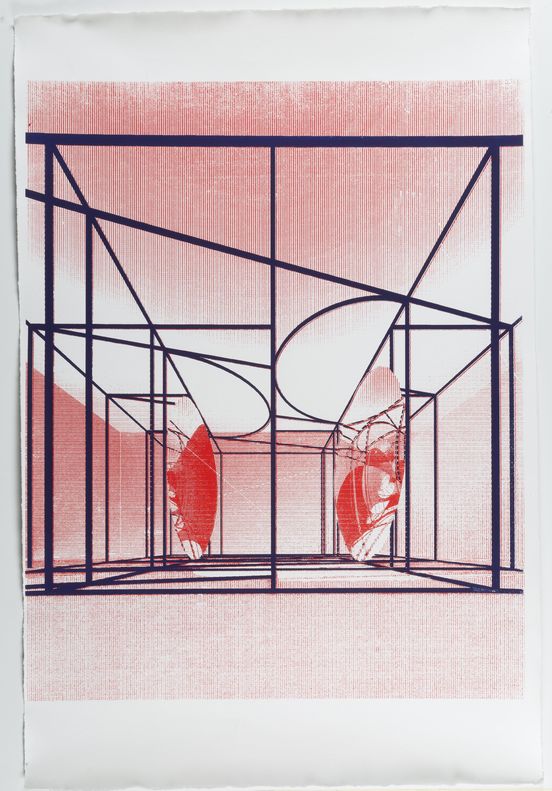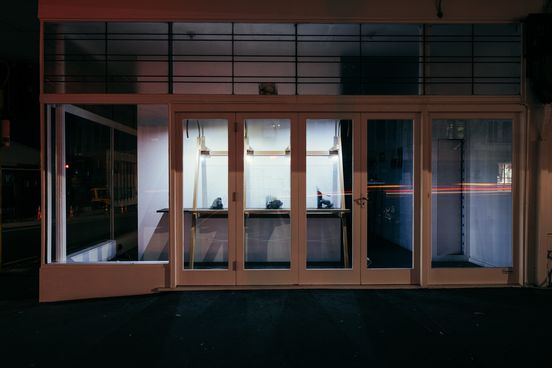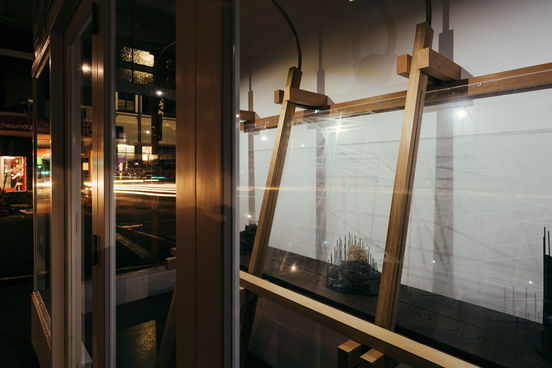Penumbral Reflections draws on ideas of penumbral shadow, the partial shadow that occurs between umbra—the darkest part of the shadow—and full illumination. The installation contains an aluminium and steel construct that merges two architectural devices—the grid and a Claude glass—through projected light and simulated shadow.
The term ‘Penumbra’ was used as a metaphor by Robin Evans to describe the murky relationship between translation and building. Drawing conventions of architects have radically changed, due to constantly evolving technologies since the first digital turn. Now, design is increasingly mediated through the simulation of images, rather than abstracted representation that never quite touches the built form. The installation is conceived as a disciplinary experiment that seeks to blur the boundary between the simulated and physical in contemporary architectural practice.
Architects have used the grid to reveal order and measurement for generations. Peter Eisenman used the grid as part of a design process to order geometry. Similarly, the volumetric grid of Penumbral Reflections has undergone a transformative process. Embedded inside the space of the grid is a super-sized Claude glass that represents its antithesis—distortion and curated scenography. Black convex pocket mirrors were first used in the 18th and 19th centuries by picturesque painters in their editing and representation of the natural landscape. The Claude glass was used to purposefully distort the reflection of a space to conform to pre-existing ideals of beauty, enabling artists to alter and fictionalise their interpretations of real landscapes. Enlarged for the installation, the oversized Claude Glass not only reflects space, but also meaningfully occupies and distorts it.
Animating the gallery are four projections of simulations of the installation, produced in gaming engines that attempt to capture the perceptual qualities of the built work. The simulations are mapped on the aluminium construct, producing misalignments between simulated and real shadow. When viewed in the curved face of the Claude glass, two penumbral zones of half shadow, similar to that witnessed in a lunar eclipse, are created. The space between the real and the simulated has narrowed in contemporary architectural practice, but it is within this penumbral space that contemporary forms of architectural representation can take shape.
The project collects architectural themes that recur in the work of PAC Studio. The installation for Objectspace seeks to distil and test these themes, before the work is permanently installed at the Waikereru Ecosanctuary, near Gisborne.
____
PAC Studio is a research-based architectural office. The studio works across residential and small-scale commercial projects, as well as designs for projects on the fringes of traditional architectural practice, including urban activation, artworks, furniture and strategic spatial consulting.
Dr Sarosh Mulla is a practicing architectural designer, artist and Lecturer at the School of Architecture and Planning at the University of Auckland. His design work has been awarded by both the New Zealand Institute of Architects and the Designers Institute of New Zealand. Sarosh is also a founding member of experimental design collective Oh.No.Sumo and is currently developing the Rainbow Machine, a large-scale public artwork for the Auckland Council.
Aaron Paterson is a practicing architect and Lecturer at the School of Architecture and Planning at the University of Auckland. In the field of residential architecture, both multi-unit housing and single dwellings, Aaron’s designs are widely recognised—as well as widely published and awarded. His research is focused on architectural representation that operates between translation and simulation.
Following its exhibition at Objectspace, Penumbral Reflections will be installed at the Waikereru Ecosanctuary in two parts. This translation from the gallery to the regenerating landscape builds on the Welcome Shelter, a live project completed as part of Sarosh Mulla’s doctoral research. The Claude Glass will be installed in the landscape, reminding viewers of the constant curation and depiction of the New Zealand landscape. The gridded frame will become a central part of a new stargazing observatory tower designed by PAC Studio. The two parts of this installation further develop the themes of mediated representation through architectural and artistic devices.



Penumbral Screen-prints, 2017, Sarosh Mulla & Aaron Paterson – PAC Studio



K Road Installation: Penumbral, 2017, Window Gallery Karangahape Road, Sarosh Mulla & Aaron Paterson – PAC Studio
